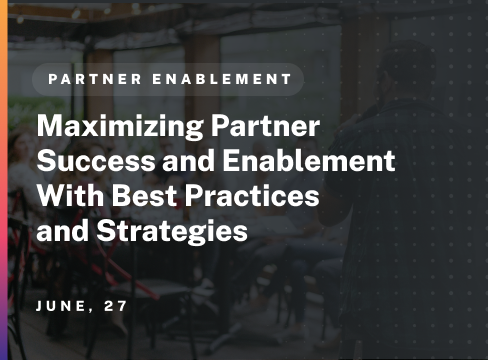Partner enablement is crucial for driving your business success and ensuring your partners have the necessary skills, incentives, and support to thrive.
With the right strategies, you can create a robust partner enablement program that fosters strong, productive partnerships. Read on to find out how to optimize your partner enablement efforts and drive significant growth and success for your business.
What is Partner Success and Enablement?
Partner success and enablement ensure that your partners have the tools, resources, and support they need to succeed. By focusing on the “better together” philosophy, you can build stronger, more effective partnerships that drive mutual growth.
Key elements of partner success and enablement include:
- Skills: Providing training and development opportunities to help partners enhance their abilities and knowledge.
- Incentives: Offering rewards and recognition to motivate partners and encourage performance.
- Mind Share: Ensuring that your partners are fully engaged and aligned with your brand and goals, fostering a sense of ownership and commitment.
Focusing on these elements can create a supportive environment that empowers your partners to succeed.
Roles and Responsibilities in Partner Enablement
Now, who’s responsible for enabling your partner?
One emerging role is the Partner Experience Manager, who focuses on ensuring a seamless and productive partnership experience. This role can vary depending on the organization and its specific needs.
Typically, a Partner Experience Manager handles tasks such as partner onboarding, training, and ongoing support. They work closely with partners to understand their challenges and provide the necessary resources and solutions. By clearly defining these roles and responsibilities, you can ensure that your partners receive the support they need to succeed.
Placement in Organizations
Where you place partner enablement within your organization can significantly impact its effectiveness. The placement should align with your company’s goals and structure to ensure optimal support for your partners.
Common placements include the following:
- Marketing: Partner enablement in marketing can help align partner programs with your brand’s messaging and promotional strategies.
- Sales: Placing partner enablement in sales ensures that partners receive the necessary training and tools to drive revenue and close deals effectively.
- Customer Education: When partner enablement is part of customer education, it focuses on equipping partners with the knowledge and skills needed to provide excellent customer service and support.
Carefully considering where to place partner enablement better integrates it with your overall business strategy.
Four Key Metrics to Track
So, how will you know you’re doing a great job at enabling your partners? There are four metrics to consider.
1. Onboarding
Track metrics such as the time it takes for a partner to complete onboarding and their initial performance. For example, measure how quickly a new partner can start generating sales after completing the onboarding program.
2. Retention
Retention rates indicate how well your partners are engaged and satisfied with your program. Monitor metrics like the percentage of partners who remain active over time. You can track the number of partners who continue to participate in your program after one year to assess retention.
3. Active Solution Partners
These are the ones consistently helping you achieve your business goals. Monitor the number of partners who are actively selling and supporting your products.
4. Engagement Levels
Engagement levels reflect how involved and committed your partners are. Monitor metrics such as participation in training sessions and attendance at events. You can do this by tracking the attendance rates at your quarterly partner webinars to gauge their interest and involvement in your program.
Legal Considerations in Certification Programs
High-stakes certifications come with specific requirements that must be met to avoid legal issues.
Key legal requirements include:
- Validity: Ensuring that the certification accurately measures the skills and knowledge it claims to assess.
- Fairness: Providing equal opportunities for all participants to succeed.
- Reliability: Consistently producing accurate and dependable results.
Meeting these legal requirements helps build trust and credibility in your certification programs, which in turn supports partner success and engagement.
Certifications vs. Credentials
There is an important distinction between certifications and credentials.
Certifications are formal recognitions that validate specific skills or knowledge, often involving high-stakes exams and stringent legal requirements. Credentials, on the other hand, can be more flexible and less legally complex, often used to recognize participation or completion of a course.
Choosing between certifications and credentials depends on your goals and the legal implications. Using credentials can simplify the process and avoid potential legal issues, making them a practical option for many partner enablement programs.
Three Tools for Partner Enablement
Utilizing the right tools is essential for effective partner enablement. Here are three key tools to consider:
1. Learning Management System (LMS)
An LMS allows you to create, manage, and track training programs, ensuring partners have access to necessary resources. Using an LMS like TalentLMS can streamline the onboarding process and provide continuous learning opportunities.
By implementing an LMS, you ensure that your partners stay updated on the latest product knowledge and skills. This tool helps in tracking their progress and performance, making it easier to identify areas where additional training might be needed.
2. Enablement Libraries
Having a centralized repository of resources helps partners quickly find the information they need, reducing downtime and increasing productivity. You can create a digital enablement library using platforms like SharePoint or Google Drive.
3. Sales Funnel Tracking
Sales funnel tracking tools help monitor and manage the progress of deals through the sales pipeline. These tools provide insights into partner performance and sales activities. For example, using a CRM system like Salesforce can track how partners are moving prospects through the sales funnel.
When to Hire for Partner Enablement
Deciding when to hire for partner enablement depends on your organization’s specific needs and goals.
Start by assessing the current gaps in your enablement program. If you notice that partners are struggling with onboarding, training, or support, it might be time to bring in additional resources. Begin with a contractor to evaluate the enablement gap before committing to a full-time hire. This approach allows you to identify key problems and solutions without a significant upfront investment.
Once the needs are clear, justifying a full-time position becomes easier, ensuring that your partner enablement efforts are well-supported and effective.
Conclusion
Partner enablement can be a game-changer for your business, fostering strong, productive partnerships. By implementing best practices, tracking key metrics, and using the right tools, you can ensure your partners are set up for success. Assess and refine your strategies regularly to drive continuous growth and improvement.
Join The 1850+ Leaders Transforming Partnerships
As a member of Partnership Leaders you will:
- Build and learn with the top partner people at the best companies around the world.
- Increase your impact and accelerate your career with proven resources, tools, and best practices.
- Grow a network of peers, partners, and advisors with common objectives.




